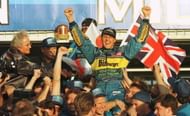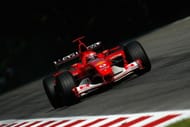“He could easily turn out to be another Senna, I’m absolutely sure of it.”
F1 supremo Bernie Ecclestone made this prediction about a young Michael Schumacher way back in 1991 when the late Ayrton Senna was still racing and in the prime of his career in Formula One. The legendary Senna himself saw ‘Schumi’ as a direct competitor during the German driver’s early days, and he had several run-ins with him in the early ‘90s. That the world never got to see the rivalry grow and flourish after that fateful day in Imola in 1994 will go down in motorsport history as one of those ‘what-could-have-been’ eipisodes.
Almost 20 years later, the words serve as a chilling reminder as the entire world reels in shock and hopeless despair after Schumacher suffered a critical head injury in a skiing accident on the slopes of the French Alps. It is almost unfathomable that a driver who risked his life countless times, driving at more than 300 km/hr on a race track, could be so vulnerable off it.
Nobody expected Schumacher to be celebrating his 45th birthday in an induced coma with doctors fighting to save his life. Just like it did on the track, it was his helmet that saved his life off it too.
It all started in 1991...
New kid on the block
The fact that Schumacher got his lucky break in Formula One thanks to Jordan driver Bertrand Gachot going to prison for ‘tear-gassing’ a London taxi driver is the stuff of F1 folklore. Jordan had been running secret tests with a young Schumacher in 1991 and he immediately caught the eye of the Formula One world.
How? He qualified seventh – an astounding achievement considering he’d never driven a Formula One car prior to that weekend, not to mention the fact that he’d achieved it on one of the most challenging and unforgiving circuits in the calendar – Belgium’s Spa-Francorchamps. The drivers who were quicker than him included champions like Senna, Nelson Piquet, Alain Prost and Nigel Mansell.
Benetton probably made their biggest (and best) decision after the race to sign him up, and Schumacher found himself in a different car in the next race at what would go on to become one of his favourite hunting grounds – Monza. A superb drive brought him home in fifth place, and a new star was born.
Two years and many podium finishes later, Senna himself became wary of this young prodigy setting the tracks alight with a tenacity that was eerily similar to the Brazilian’s aggressive, and sometimes crazy, manoeuvres – albeit with the element of calculated risk. The year Senna died, Schumacher won his first title, and predictably the comparisons between the two began to come up. Schumacher would go on to win a second title the very next season to become the youngest two-time champion in history.
The Prancing Horse finds its knight in scarlet red armour
The jump to Scuderia Ferrari, a team that last won the title in 1979, was hard to comprehend for many. It was Benetton’s work on the car that caused points to be controversially dropped in 1994 that was the foremost reason for his decision.
But the move still took some convincing, and the person responsible for bringing him to Ferrari was none other than Jean Todt, the man charged with bringing the glory days back to Ferrari. A lucrative deal was signed and Schumacher traded in the bluish-green suit for the scarlet red one that he would soon be identified with the world over.
“I did not know what Ferrari was when I joined, and I had to learn that. It was a challenge to go there because they had been so unsuccessful.”
A year later, Benetton’s Technical Director Ross Brawn joined him at Ferrari and together with Schumacher and Todt, they set about writing history. A team steeped in motorsport history was struggling with their once renowned V12 engines while their competitors used lighter V10s.
The process was a long journey, but Ferrari slowly and steadily improved their performances over the years. Barring a disqualification in the 1997 season for unsportsmanlike conduct during one of his legendary battles with Jacques Villeneuve, Schumacher and his team managed to stay in the hunt. 1999 brought them a Constructors’ title, with Schumacher’s World Championship challenge derailed by a broken leg at the British Grand Prix.
Ferrari finally tasted success as they entered a new era – one in which, with Schumacher’s help, they would go on to be the most successful team in Formula One history. After a drought that lasted 21 years, Ferrari had a World Champion. 2000 to 2004 was the German’s time as he would go on to win five titles in five consecutive seasons.
Such was his dominance that he made the podium in every single race in the 2002 season, scoring a massive 144 points in the process. This was back when a win gave a driver only 10 points. To put that into perspective, only 6 drivers from last season managed to beat that tally with the new points system!
Michael-mania reached a whole new level as the sport benefited from improved coverage and endorsement deals. According to Forbes, Schumacher became the second highest paid sportsperson in 2004 and a year later he became the world’s first billionaire athlete.
The road to success wasn’t without its fair share of controversies on the track though. From the “team orders” fiasco Ferrari got embroiled in when fellow driver Rubens Barrichello allowed Schumacher to overtake him on the final lap to claim victory at Austria in 2002, to Schumacher charging into the McLaren pit garage to confront David Coulthard after a collision ended both their races at Spa in 1998, there was never a dull moment when the German was around.
Wheel-to-wheel racing with a never-say-die attitude was Schumacher’s claim to fame and success. But there were a number of unforgettable moments when he didn’t allow an opponent to pass – even bending the rules to maintain his position – such as his run-ins with Damon Hill, Coulthard and Villeneuve.
Completing the legend
Schumacher transformed a team of has-beens into world beaters and transformed an elitist sport into one followed and enjoyed by the young and old alike, which was why many a Formula One fan shed a tear when he first retired in 2006. Everyone who watched him race will always remember his last race with Ferrari.
Starting in tenth place on the grid in the Brazilian Grand Prix, a tyre puncture saw him fall down the order to 19th. What happened next was that the world got to witness one of Schumacher’s most glorious drives as he overtook one car after another in a remarkable show of pure, unbridled racing to finish the race in fourth place – a drive that “summed up his career”.
Although Schumacher did make his return to Formula One for Mercedes in 2010, it was far from being a fairy-tale second coming. Just one podium finish (third place at the 2012 European Grand Prix) in three seasons with a considerably weaker car saw his stock fall, but not his reputation. He was still happy to get behind the wheel even though he was now in his 40s, as his compatriot and protégé Sebastian Vettel racked up the wins and titles, getting ever closer to his record of seven World Championships.
What was a major factor in Schumacher’s legacy was that as charismatic as he was on the track, his demeanour off the track was a shining example of how celebrities should behave. Not one to bask in the spotlight, he led a quiet life away from the public eye and maintained a simple lifestyle, donating to various charitable causes whenever he could. In fact, his donation to the tsunami relief efforts along the Indian Ocean eclipsed those of many countries!
Schumacher has seen and done it all in Formula One racing; that comes with the package when one is involved with the sport for more than two decades. He has raced with V12s, V10s and V8s. He has seen the rules and technology change time and again – be it with respect to pit-stops, refuelling and tyre changes or from driving cars with barely any electronic aids to those that helped him control its various features with just a push of a button. Evolution demands adaptability and Schumacher excelled in that aspect.
It’s hard to process that he has raced with some of the most recognizable drivers in history across generations – from Ayrton Senna, Nelson Piquet and Alain Prost to Damon Hill, Jacques Villeneuve and Mika Hakkinen to Fernando Alonso, Kimi Raikkonen and Sebastian Vettel. Most of these drivers were just mere specks in his rear-view mirrors in the years he dominated the field, as he racked up points, wins and a reputation with a serious claim to being the greatest of all time.

One last race
I’ve had the privilege of seeing Schumacher race in his prime, and I have learned to live with not seeing a scarlet red helmet in a car, resolutely making its way around a race track. I’ve had to do that twice already, in 2006 and in 2012. But with the thoughts and prayers of millions of people around the world, I can only hope that he recovers fully for the sake of his family and for the sport in general. All everyone wants is to see him hale and hearty again. The sport is already poorer without him, and I wouldn’t want his family and fans to suffer the same fate.
91 race wins. That was the number at which Schumacher finished his celebrated career. As he fights his toughest battle yet, one for his very own life, I can’t help but look back at how he carved his way through the field to claim victory – slowly and methodically.
It’s been a long race, his longest one yet. But Schumacher is no stranger to racing; he’s been doing it ever since he was a 4-year-old kid in the German town of Kerpen.
Get well soon, Schumi! The chequered flag for win number 92 awaits.


